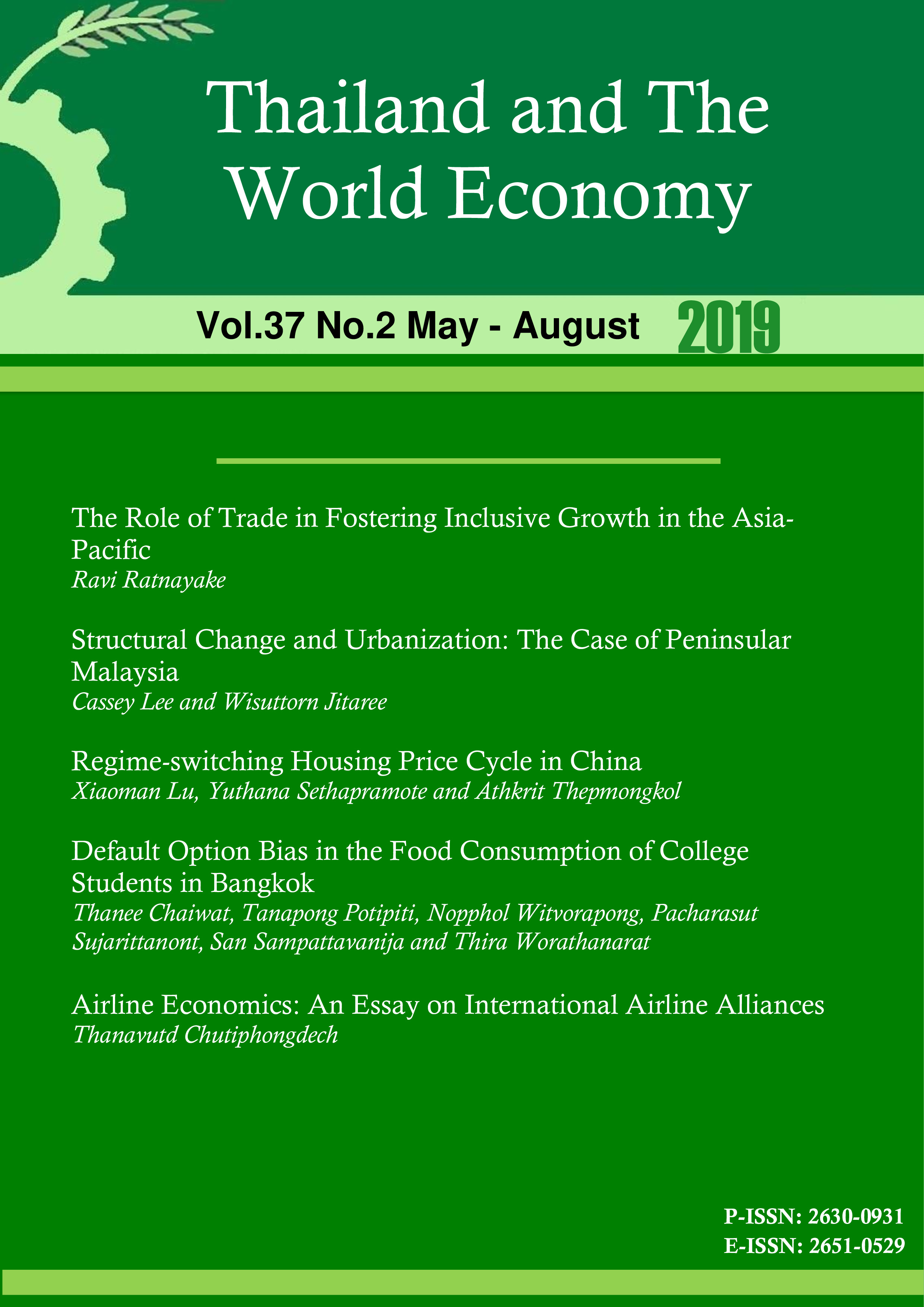Regime-switching Housing Price Cycle in China
Keywords:
House price cycle, Markov switching model, ChinaAbstract
This paper aims to examine the house price cycle at the province level in China using the three-regime Markov-switching model. Our findings indicate that, in Xinjiang, Chongqing and Jiangsu, there was no secular slowdown in growth since the rapid-growth regime re-emerged at some stage. While during economic downturns and periods of rapid economic growth, house prices fall and grow fastest, respectively, in the central region. However, during a normal growth regime, house prices increase fastest in the eastern provinces. These findings indicate regional heterogeneity in China. We also investigated the determinant factors of regime switching in each region. Our results show that output growth and real lending rates are two common factors in the co-movement of the smooth probabilities of recession. Therefore, it should be possible to apply a uniform housing policy for the whole country, but only when house prices are in recession. However, in most cases, the government should implement a different policy according to the local conditions and determinant factors of each region.
References
Alvin H. Hansen. (1964). Business cycles and national income (1st ed.). W.W. Norton & Company.
Artis, M., Krolzig, H., & Toro, J. (2004). The European business cycle, 56(October), 1-44.
C Chang, C., & Nelson, J. (1999). Cryogen spray cooling and higher fluence pulsed dye laser treatment improve port-wine stain clearance while minimizing epidermal damage. Dermatologic Surgery, 25(10), 767-772.
Chowdhury, R., & Maclennan, D. (2014). Regional house price cycles in the uk, 1978-2012: A markov switching VAR. Journal of European Real Estate Research, 7(3), 345-366
Corradin, S., & Fontana, A. (2013). House price cycles in europe. Working Paper Series No.1613, European Central Bank.
Dijk, D. Van, & Franses, P. H. (1999). Modeling multiple regimes in the business cycle. Macroeconomic Dynamics, 3(3), 311-340.
Fang, X., Zhang, S., & Feng, J. (2013). A study on the measurement of real estate price bubble and regional difference-taking 35 large and medium cities in China as an example. Economic Issues, 11(1), 5-10.
Fu, C. (2013). The comprehensive analysis of factors influencing China’s real estate prices. Economic Issues, 9(1), 49-52.
Girardin, E. G. (2005). Regime-dependent synchronization of growth cycles between Japan and East Asia. Asian Economic Papers, 3(3), 147-176.
Gu, H. (2013). An empirical study on China’s real estate cycle based on Hodrick-Presott filter. Construction Economy, 12(1), 83-86.
Gu, J. (2007). Model analysis of Shanghai real estate cycle fluctuation. Shanghai Economic Research, 8(1), 53-66.
Hamilton, J. (1989). A new approach to the economic analysis of nonstationary time series and the business cycle. Econometrica, 57(2), 357-384.
He, G., Cao, Z., & Li, C. (1996). Research on China ’s real estate cycle. Economic Research, 12(1), 166-173.
Kim, C. J., & Piger, J. (2002). Common stochastic trends, common cycles, and asymmetry in economic fluctuations. Journal of Monetary Economics, 49(6), 1189-1211.
Krolzig, H. M. (2000). International business cycles: Regime shifts in the stochastic process of economic growth. Applied Economics Discussion Paper No.99194, Institute of Economics and Statistic.
Krolzig, H., & Toro, J. (2001). A new approach to the analysis of business cycle transitions in a model of output and employment. Economic Series Working Paper No.9959, University of Oxford.
Lee, C., Liang, C., & Chou, H. (1997). Identifying Taiwan’s real estate cycle turning points - application of the two-variate markov-switching autoregressive model. Taiwan Land Research, 11(2), 155-177.
Li, J., & Guo, Z. (2011). Study on the relationship between urban housing price cycle based on spectral analysis - taking wuhan as an example. Journal of Hubei University of Economics, 9(5), 45-49.
Liang, Y., & Gao, T. (2007). An empirical analysis of regional difference in real estate price fluctuation in China. Economic Research, 8(1), 133-142.
Luan, T. (2016). Regression analysis of factors affecting house price in major cities in China. SHANGYE JINGJI, 473(1), 5-15.
Luo, H. (2011). Analysis on influencing factors and transmission mechanism of periodic fluctuation of China’s real estate. Market Forum, 5(1), 4-6.
Luo, X., Hong, B., & Ma, S. (2012). Research on influencing factors of real estate price based on var model. J. CENT. SOUTH UNIV. (SOCIALSCIENCE), 18(4), 1-7.
Ma, W. (2007). Hangzhou real estate cycle fluctuations and comparison with Japan, Hong Kong. Comparison of Economic and Social Systems, 5(1), 131-136.
Sun, W., Zhu, A., & Wang, Y. (2011). A quantitative analysis of the factors influencing the regional difference of real estate price. Taxation and Economy, 117(1), 1-7.
Xia, C., Cao, Z., & Zhuan, Y. (2012). A comparative study on the characteristics of China - US real estate cycle fluctuation. Statistics and Decision, 7(1), 133-135.
Xu, H., Tang, Z., & Ba, S. (2010). An empirical analysis of the fluctuation of real estate price growth cycle in China. Journal of Shanghai University of Finance and Economics, 12(2), 2010-2012.
Zhang, Q., & Zeng, J. (2013). An empirical study on credit policy and real estate price cycle fluctuation. Theoretical Exploration, 12(1), 8-12.
Zhao, Q., & Shi, Y. (2015). Study on housing price cycle and its influencing factors. Research on Economics and Management, 36(2), 88-93.










